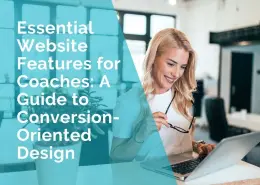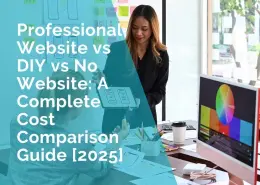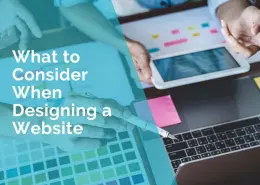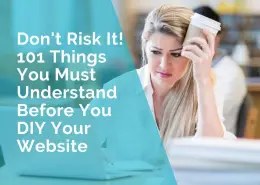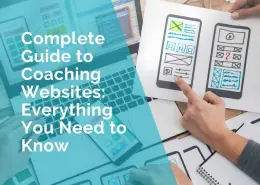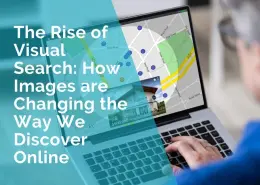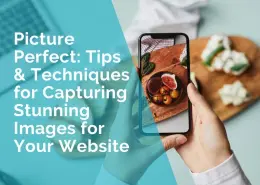Website Design Checklist – 16 Steps to an Awesome Wordpress Website
Before you read any further, I need you to understand a few things about the website design process:
- Creating a successful website that brings you a stream of hot leads and paying customers takes time – more than an hour, a day or even a week.
- You will need to get comfortable with being uncomfortable and learn new ways of running your business.
- And just when you think you have it figured out, things will change.
- You will need to learn how to deal with overwhelm and fear and push through challenges and roadblocks.
- You will have to understand your target audience, their pain points and figure out how to solve their problems.
- You will need to stop making excuses and start taking action.
- Some days technology will be your friend. Other days it will drive you crazy.
- And if you are wondering if you even need a website, read the 27 reasons why your business needs a website.
- The process can be made easier and faster if you hire a professional website designer. But even then you need to have realistic expectations of what can be achieved.
I don’t mean to scare you, but I want to be real with you, so that you don’t waste your time, money and energy. If you’re not ready to face all this, it’s ok. It may just not be your time, yet.
But if you are still with me and ready to go, let’s get started! In this Web Design Checklist we will cover:
- What domain name to register
- Best tool to create your website
- What information to include on your website
- Best copywriting practices
- Ideal website layout, colours and fonts
- Where to source suitable images without spending a fortune
- What trust icons are and why you need them
- Google Analytics
- Plugins and additional functionality
- How to back up your website?
1. Register Your Domain Name
The purpose of a domain name is similar to that of a street address. The domain name directs customers to your website.
A domain name normally consists of 2 parts:
Part 1
- your business or company name, eg. “Nike Inc”
- derivative of your business name, eg. “Web4business”
- your brand name, eg.”Nespresso”
- what you do, eg. “Strategic Consultant” or
- your name if you have a personal brand, eg. “Amy Porterfield”
Part 2
The organisation type/region.
.com.au – Commercial Organisations in Australia
.net.au – For network infrastructure and Internet Service Providers in Australia
.gov.au- Australian government and semi-government departments
.org.au – For clubs and various forms of affiliation groups in Australia
.edu.au – Australian educational institutions
.asn.au – Australian associations
.com – Commercial organisations in the United States
.net – For network infrastructure and Internet Service Providers in the United States
.gov – US government and semi-government departments
.edu – Educational institutions in the United States
Before you register a domain name, consider the long term plan for your business. For example, if you are a travel agent and wish to initially specialise in Family travel, but then also expand into corporate travel, do not register a domain name such as Familytravel.com, but go wider and register a domain such as ultimatetravel.com.
If you haven’t yet registered your business or company name, it may be a good idea to see what domain names are available first.
Rather than rushing into registering a domain name, I would recommend you:
- Brainstorm potential domain names
- Check if they are available for registration. Click here to check.
- Leave them for a few days so you can be totally clear on the best domain name is for your business.
- Register your favourite domain name – Click here to register.
For more information about domain names – check out Domain Names – All You Need to Know which answers questions such as:
- how many domain names to register
- what happens if you don’t register a domain name
- how much does a domain name cost
… and more
2. Organise Webhosting
Think of web hosting as renting space for your website on a powerful computer (also referred to as server). It is similar to renting office space for your business.
Instead of storing desks, chairs and printers, you store files such as website pages, images, pdf documents, slideshows, etc)
Without a web hosting account, no one would be able to see your website.
Generally, there are four different types of web hosting:
- Shared
- Virtual Private Server (VPS)
- Dedicated
- Cloud Hosting
Whilst all types of hosting servers act as a storage centre for your website, they all have different capabilities when it comes to the amount of storage space, technical support, server speed and reliability.
Just like in real life … more often than not you get what you pay for.
When comparing webhosting companies, ask the following questions:
- What is the guaranteed uptime?
- Where are the servers physically located?
- What level of technical support do they offer? Online only / phone / email?
- What hours is technical support available?
- What type of set up assistance is available at no additional cost?
- How much disk space is provided
To learn more about webhosting companies and the questions you should ask, check out Webhosting Plans – Everything You Need to Know.
If you don’t have time to compare hosting companies, I would recommend going with Siteground – Their service is reliable, hosting plans are flexible, and their customer support is one of the best in the industry. Check out their pricing webhosting pricing plans here.
Don’t forget about SSL certificate
An SSL certificate is an important security measure for any website. It provides an encrypted connection between your web server and a client’s browser, ensuring that all data passed between the two remains private and secure.
An SSL certificate also authenticates the identity of the website and helps to build trust with customers by reassuring them that their connection is safe.
Your hosting company will be able to organise this for you.
3. Choose Colours and Fonts for Your Brand
One of the first decisions you will need to make when it comes to designing your website are the colours and fonts.
Believe it or not, colour choice can play a big part in the success of your website.
Neil Patel (digital marketing guru) explains How to Use the Psychology of Colour to Increase Website Conversions.
Once you have an idea on what colours to choose, check out these colour palettes to figure out complementary colours which will enhance your website. https://colorpalettes.net/

Your website needs to be as easy to read as it is visually appealing – having breathtaking designs with illegible typography will confuse your viewers and they will quickly leave.
As such, it is important to use web fonts which will be clear not only on large monitors but also mobile devices.
You can use different fonts to help differentiate between types of information – heading, body text, internal links and navigation, making your website clearer and easier to understand.
Google offers 900+ fonts which you can use on your website. If you have a Wordpress website, you can simply install the Google Fonts plugin.
The Google Fonts Interactive Library allows you to test different styles and font properties including size, thickness, slant and width.
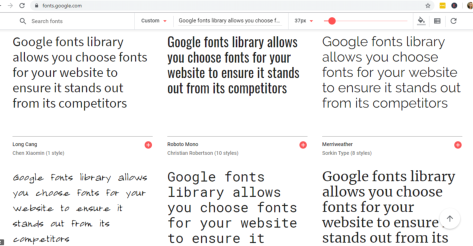
4. Get a Logo Created
Now that you have an idea on what colours and fonts you like it’s time to create your company logo. I would highly recommend you get a professional graphic designer to design it for you.
Your logo is often the first thing potential customers see on your business cards, website, blog, social profiles, merchandising materials etc, so it’s important you get it right.
If you are wondering whether you need a logo, then let me clear that up for you.
YES ABSOLUTELY.
Here’s why …
- Make a great first impression
- Attract new customers
- Stand out from your competition
- Portray a professional image
- Let your customers know what your business is about
- Help customers to remember you
It’s important that your logo:
- looks good not only in colour, but also in black and white
- works well online and in print
- is able to be scaled without losing quality
Cost to develop a logo can vary greatly. While some branding agencies will charge in excess of $1000, our graphic designers can create an affordable logo for you. The cost is just A$330 for 3 different concepts with 3 revisions.
Here are some examples of great logos from our graphic designers.
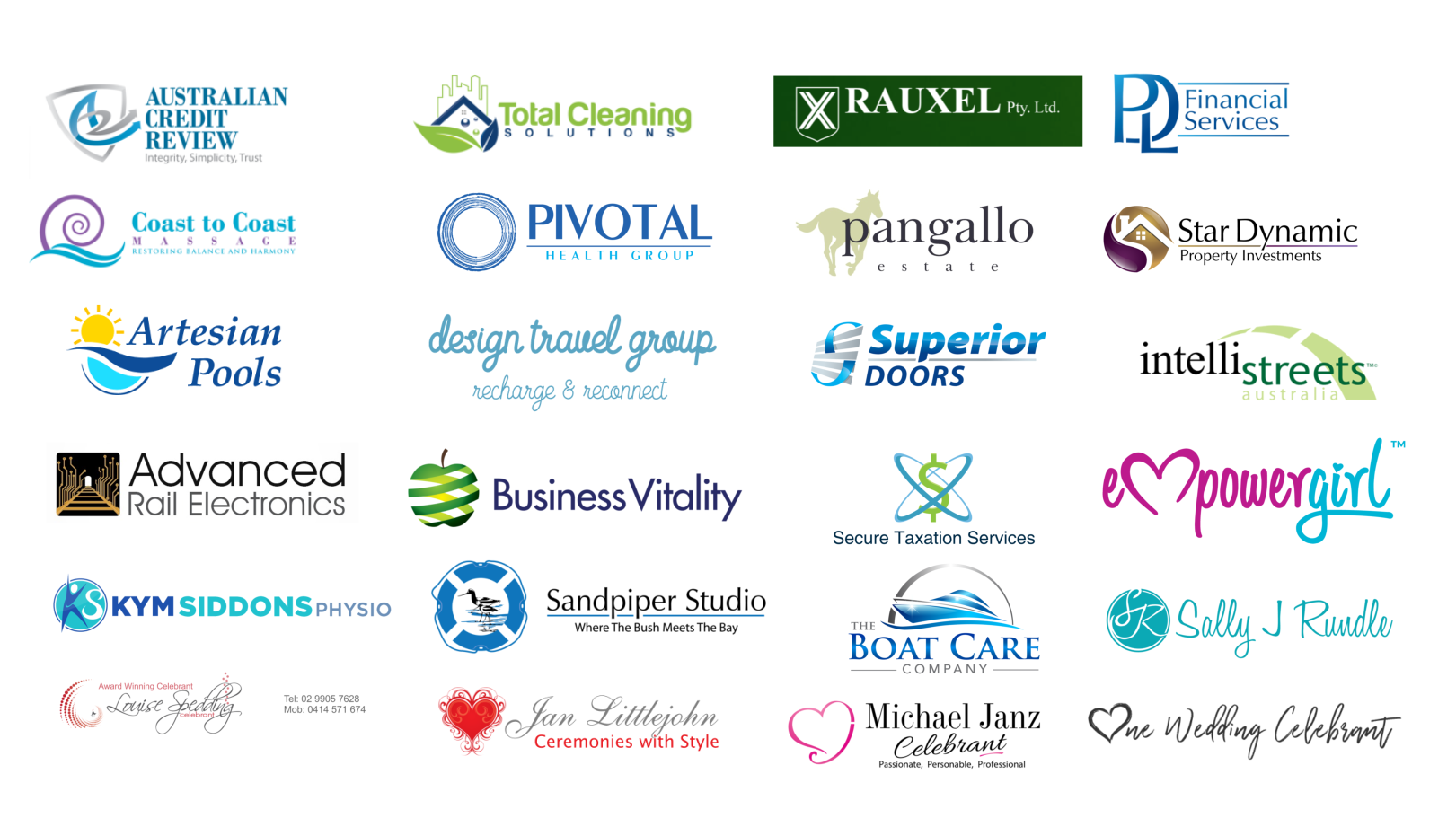
Learn more about our logo design service
5. Gather Information for Your Website
Whilst having a visually appealing website is important, including the right content is far more critical.
Website Content
When someone is looking at your website, they want to know you can solve their problems and if you don’t show them how, they will go and find someone else who will.
Remember, people don’t care about you, your business or your website. They care about how you can help them.
You can do this by including all the essential pages including:
- Homepage
- Products / Services
- Contact
- About
- Testimonials
- Frequently Asked Questions
- Terms & Conditions
Other pages to consider
- Blog
- Resources
- Links
- News
- Pricing
For a list of The Most Important Pages To Include On your Website, read The Most Important 24 Pages To Include On Your Website
Website Credibility
But simply including lot of information is not enough. You also need to prove to your customers that you are trustworthy, reliable and that you will deliver what you have promised.
This can be done via trust icons such as:
- testimonials,
- before and after photos,
- portfolio,
- trade memberships,
- media features,
- product reviews,
- third party certifications
- awards …
Learn more at Top 24 Valuable Ways To Boost Your Website’s Credibility
Website Copy
Struggling to write high-quality, compelling copy? The devil is in the detail. Small tweaks create big wins.
Are you inundated with sales pitches screaming buy this, try that, click here, register… and don’t know how to stand out?
Don’t panic, here are 5 easy, sure-fire tips to add some punch to your content.
- Play the game
Seduce your reader from the very first line.
Write about their problems. Quickly grab their attention and use the power of mirror neurons and emotion to fuel their curiosity.
Engage your reader’s senses. Make them feel something; cringe, jump, tingle. Create vivid mental images and take them on a journey of wanting to read more.
- What’s in it for me?
We know the customer is always right.
They aren’t interested in our products, our business, or us. They just want to know what’s in it for them.
Research. What problems do you solve for your reader? Know what they want, get them excited and drive them to want to buy.
Personalisation is also your friend. Using your customer’s name where appropriate and build trust and credibility, makes content much more engaging.
- Ask questions
Writers, are you listening? What are you concerned about?
Don’t be afraid to put it out there. Make it relevant. Grab their attention. Create the nodding effect and have him or her agreeing, or at least thinking you have the answers.
Having a succinct and challenging opening sentence will instantly make your copy more engaging. Let them know you will solve their problems quickly and they’ll be more likely to read on.
- Own the short and sharp
Don’t waste precious pixels. With our screens getting smaller and multitasking and multiscreening empowering digital generations, we have to grab attention fast.
We must minimise distractions. Cut out the crap. No salesy words or phrases. If you have to say you are innovative or market leading then you most probably are not.
Be specific and don’t generalise where possible. We have reached 2683 followers, has more credibility than ‘we have thousands of followers’.
Keep it simple and direct. Tell readers exactly what you want them to do. Don’t waste their time.
- Learn to love the power words… and verbs.
Don’t rely on adjectives to add colour to your copy. Go active on the verbs to add pace and punch.
Keep them glued with the use of you, free, because, straight away, instantly and new. People block out sales pitches so remember to use the words effectively.
Also, everybody loves a story and emotive transportation leads to conversion.
Power words allow your reader to become more engaged, trusting and evoke a sense of fast reward.
Want to find out more ways to improve your copy and learn how to make the most of your website?
Check out Savvy Woman’s Practical Guide to Online Business (even if you are a man :))
Pro Tip:
If you are linking to other websites from your content, make sure the website you link to opens in a new tab. That way, when the visitor is done reading the content on the other website, your page will still be open for them to return to.
6. Source and Create Images and Banners for Your Website
Images can make or break the look of your website and can make a difference between whether your website looks amateurish or professional, so choosing great images is crucial.
But where do you source images from?
Google Images
Firstly, under no circumstances should you ever use images from Google images. Just because they are available on the internet, doesn’t mean they are free to use.
With technology like TinEye.com and Images.Google.com it is now very easy to find copies of images on the internet.
Try it with a picture of yourself or a holiday snap you uploaded to Facebook. You might be surprised at where it shows up on the internet.
So how do you use images online without getting into trouble?
You need to own copyright to the image, or have a licence to use the image and be able to prove it.
There are several ways to get great relevant images.
Take Your Own Photos
Take photos and videos with your smart phone.
I snap photos wherever I go – gorgeous sunset, picture of a sandwich (you never know when that may come in handy), friend working on a computer, etc.
Google loves original content including images, so having your own photos may help your website rank higher.
Free Image Banks
There are several image banks which allow you to use free images under the creative commons license, but be aware that many other people will be using these images
Check out: pexels.com and pixabay.com
Professional Image Banks
It is worthwhile to invest some money into getting high quality, professional images. There are many excellent image banks, which have hundreds of thousands of photos and graphics for you to choose from.
Some of these include:
- Shutterstock
- Getty images
- Dreamstime
- iStockphoto.com
- Adobe image
If you want to add a little interest to your images you can do that using image editing software before uploading the pictures to your website.
There are many free or inexpensive tools, which you can use including:
- Canva
- PicMonkey
If you want something local on your machine, I recommend Xara Photo & Graphic software.
Poor images on your website will negatively impact the impression your visitors have of your business, so ensure the images on your website, blog and on your social media profiles are relevant and good quality.
Embed blogs into your website to further engage your audience by providing valuable content and updates. This not only enhances your site’s SEO but also helps in establishing your brand as an authority in your niche. Leveraging quality visuals alongside insightful blog content can significantly improve user experience and retention.
7. Create Videos and Upload them to Video Hosting Platform.
If pictures speak a thousand words, imagine what a video could say about your business.
Over the last few years video has become a popular marketing strategy, as it can quickly generate traffic and interest.
Unfortunately many people are still afraid to use it and think it’s difficult to do.
Adding video and audio files to your website can be a great way to engage your site’s visitors. Videos are more likely to capture user’s attention than text alone, while audio files provide an alternative way of conveying information.
So now is the perfect time for you to get ahead of your competition.
One of the major advantages of videos to traditional written marketing is that it saves your visitors a lot of time understanding what is being offered and there isn’t much effort required on their part.
Start the video and everything is explained to them right there and then. Hearing and seeing you tell them about your products or services has more credibility and allows you to connect to your visitors on an emotional level.
Another great advantage of video marketing is that if you use the right keywords in your video’s tags, you have a much better chance of reaching high rankings in many search engines.
To discover how to make the best videos for your website, check out
8. Plan Layout and Structure of Your Website
Before you start building your website, you need to create a plan of all the web pages you will include on your website and the layout of each page. This is to ensure your website is user friendly so that your visitors have a great user experience (UX).
You can do this using:
- Pen and paper
- Whiteboard
- Microsoft Powerpoint
- Adobe Photoshop
- Adobe InDesign
- Xara Photo & Graphic Editor
First let’s look at the elements your homepage should include:
You have 7 seconds to grab someone’s attention and entice them to read more or take action.
Ensure you include the following and you will be far ahead of your competition:
1. Easy to Understand Tagline
The minute a customer arrives at your website, they need to understand what it is that you do and what problems you are going to solve for them.
You can do this by prominently featuring your hook or slogan.
Your tagline should be memorable, straight to the point, differentiate you from your competitors and include a key benefit.
2. Solve Problems
Don’t tell your visitors how great your business is, how you use the latest equipment, greatest techniques and offer the best service. No one will believe you.
Make your homepage about how your products/services will solve your customers’ problems.
Show that you understand what they are going through and explain why you are the authority on solving the issues.
3. Calls to Action
Tell people exactly what you want them to do when they arrive at your website.
Do you want them to:
- contact you
- book a consult
- download a report
- subscribe to your newsletter
- sign up for a webinar
- follow you on social media
- request a quote
Show them where and how.
4. Catchy Headlines
You only have a few seconds to get your visitor’s attention, so make sure you include great headlines which will make them want to read more.
5. Visual Appeal
Images you use should tell a story of how your products and services solve your customer’s problems and what their life will look like after using your products or services.
6. Videos
People have short attention span and often prefer to watch videos rather than read pages and pages of text.
It is a good idea to have a video which welcomes your visitors and gives them a brief overview of what they will find on your website
7. Easy Navigation
Make sure your visitors can easily navigate to other parts of your website by including a simple navigation system – either at the top or left handside.
The navigation bar needs to be on all pages. Remember, not everyone will arrive at your website via your homepage.
8. Credibility
This is best done by including testimonials, before & after shots, awards you have won and successful case studies of customers you have helped.
Include these key elements on your page to ensure your visitors stay for long enough to find out what you do and eventually convert into paying customers.
Here are some examples of website layouts created before a website was built.
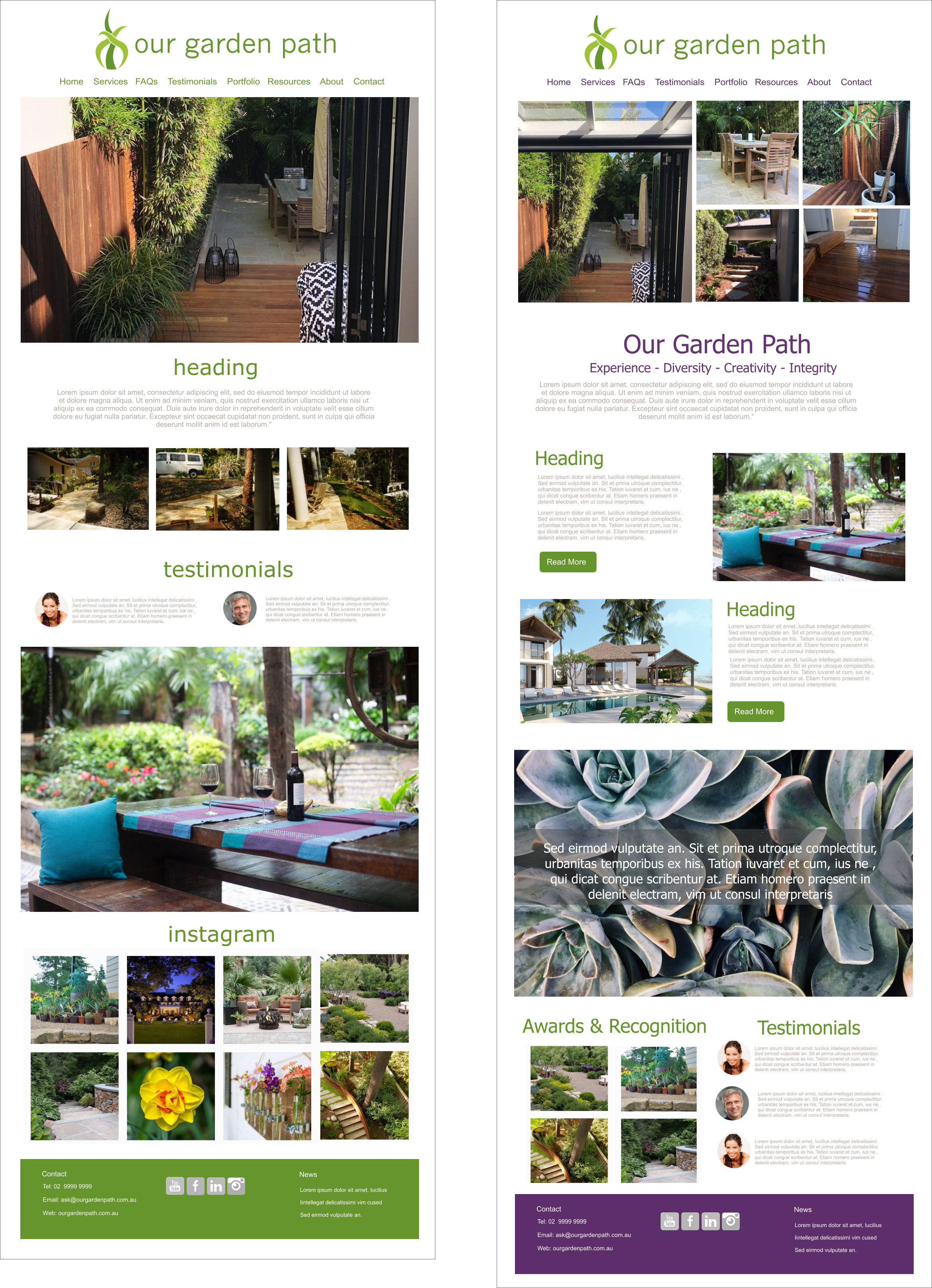
For elements to include on Internal pages check out How to improve the design of your internal web pages
Steps 1 – 8 apply to websites no matter what web development platform you use. However, before you proceed any further, you will need to decide which tool to use to create your website, even if you are hiring a website designer / developer.
There are many tools for you to choose from including Wix, Weebly, GoDaddy Website Builder, Squarespace, JimDo etc.
However, I would highly recommend you consider Wordpress.
Wordpress has evolved to become one of the most popular web publishing platforms.
- With the right theme, it gives you the ability to easily update your website
- It is mobile responsive
- It can handle many different types of media
- You can move it between hosting companies
- It is open source, which means thousands of developers work on it constantly improving it, making it more secure and functional
- You have a large selection of plugins to provide you great functionality
- You are able to easily integrate many services
- It is search engine friendly
- Great support available from Wordpress experts and developers
Wordpress is what’s referred to as “Open Source” project and what that means is that there are hundreds of developers from around the world constantly working on improving it.
With that said, let’s move onto the next step …
9. Install Wordpress
In case you are not familiar with Wordpress, let me explain.
WordPress is a popular open source content management system (CMS) used by many websites and blogs. It’s simple and intuitive interface allows users to easily create and manage content such as posts, pages, media and more.
WordPress is based on PHP and MySQL which makes it highly customizable and extendable through plugins or themes. It is also user friendly for non-technical users and offers powerful features for developers.
Installing Wordpress on your hosting account is a pretty straight forward process. Watch the video below for step by step instructions.
Learn more about other website builders
10. Choose a Wordpress Theme and Install It
When it comes to choosing a theme for your Wordpress website, you have a big choice.
There are thousands of themes – some free and some paid.
Wordpress also comes with several basic themes.
One common misconception is that a theme provides the design of your website, but in fact a theme is what helps you create the design, layout and provides some of the functionality.
Some themes come only with basic functions, so if you want to have a slideshow or a photo gallery, you may have to install extra plugins.
Themes are developed by programmers around the world and can vary greatly in quality.
My recommendation would be to get a paid theme that has had more than 3,000 downloads. That way the developers have a vested interest in keeping it up to date.
On the other hand developers who have created a free theme and hence are not being paid for their efforts have very little incentive to keep updating it.
Wordpress is constantly evolving and changing. If you’ve had a Wordpress website for a while you will have noticed that every couple of months Wordpress releases a new version and if your Theme is not being updated, you may find that after a while it stops working.
Some of the theme features you should look out for:
- mobile responsive
- offer tech support
- great rating
- simple to use
- compatible with all browsers (Safari, Chrome, Edge, Explorer)
- should be compatible with popular plugins (such as Mailchimp, Infusionsoft, WooCommerce)
One great place to source a good quality theme is ThemeForest.
ThemeForest provides you all the critical information you need to know about the theme:
- number of downloads,
- user rating,
- plugins that it’s compatible with with
- preview the theme.
ThemeForest also allows you to choose themes based on certain criteria, such as price, rating and what it’s compatible with.
My recommendation for a theme is Enfold theme.
I have used it for several years and the theme just keeps getting better.
- It has been downloaded over 100,000 times so you know it is a quality theme, which uses drag and drop functionality.
- Tech support provided by the developers is excellent. If you are unsure how to do something or you wish to do a more advanced customisation, they will help you out.
- The theme is mobile responsive, so it looks good on large monitors as well as mobile devices without you having to do anything extra
- It is also search engine friendly
- And most importantly, it keeps getting updated with each Wordpress release.
Some entrepreneurs are hesitant to use a theme which is being used by so many other people, because they believe their website will look like everyone else’s, but that is simply not true.
Here are some examples of websites I have created with the Enfold theme.


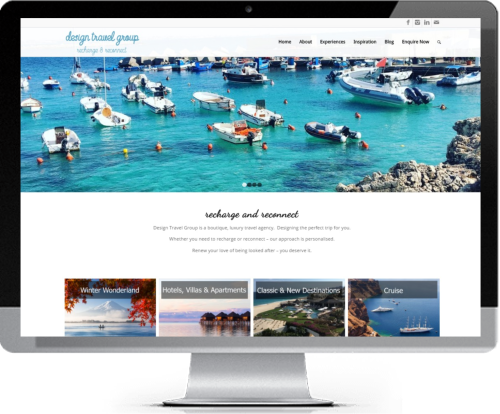
11. Add Text, Images, Slideshows, Videos, Photo Galleries, Maps
If you have completed steps 5 – 8 and have prepared the content for your website this should now be a straight forward exercise.
The Enfold theme allows you to easily drag and drop elements including:
- Text Boxes
- Testimonial Element
- Images
- Slideshows
- Buttons
- Blog Feeds
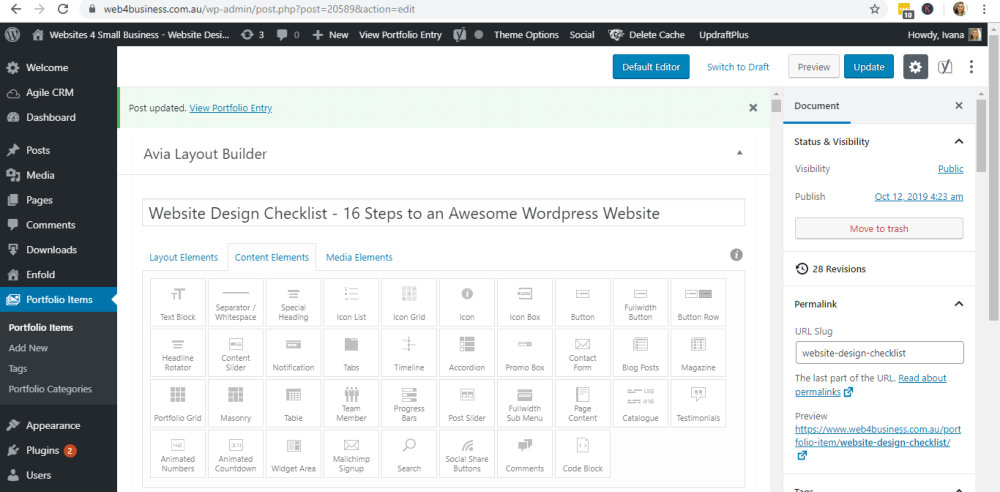
12. Install and Configure Plugins for Additional Functionality
Your website can be so much more than just a pretty online brochure.
In fact, if you want to make the most of your website, then you will want to consider more advanced functionality.
In Wordpress extra features can be added using plugins.
A plugin is a piece of software containing a group of functions. Kind of like an app on your phone.
It is important you only use plugins which are compatible with your version of Wordpress. Just like with your theme, you are better off to use plugins which have been downloaded, used and rated by many other people.
Here are some plugins you may want to consider for your website.
Website Security
These plugins help to protect your website from spammers and hackers.
Plugins: – iTheme Security, Wordfence
Forms
These are ideal if you want to include a more advanced form, such as a customer questionnaire
Plugins: Contact Form 7, Ninja Forms,
Ecommerce
Sell digital or physical products via an online store
Plugins: WooCommerce, WP Simple Paypal Shopping Cart
Social Media Sharing Plugins
Allow people to easily share the content of your website on their social networks.
Plugins: Shareaholic, Social Share Buttons
Easy Calling
This allows customers viewing your website on their mobile phone to call you with just one click
Plugins: Call Now Button, Mobile Call Now
Email / Autoresponders
Collect visitor emails and then keep in touch with them via automated autoresponders or email newsletters
Plugins: Mailchimp, Getresponse
Search Engine Optimisation
Want to optimize your website for the search engines to ensure you rank above your competitors?I
Plugins: All In One SEO or Yoast
Appointment and Workshop Bookings
Allow customers to book an appointment with you or reserve a spot at a workshop
Plugins: vCita, Bookly, 10to8
Membership and Online Course
Set up a members only area on your website or create an online course.
Plugins: Membership – Membermouse, Paid Membership Pro, Member Press
Online Course – LearnDash, LearnPress
13. Add Google Analytics
Monitoring your traffic needn’t be difficult or expensive. In fact, one of the easiest tools for monitoring traffic is completely free – Google Analytics. This allows you to get information regarding where visitors are coming from, what keywords people are using to find your website, what pages they are viewing and so much more.
If numbers are not your thing, Google has a great free course which teaches you how to make the most of Google Analytics. Check out Google Analytics Academy
14. Check How Your Website Looks in Different Browsers and On Different Devices
When you have designed your website it’s important that you check how it looks on different devices and in different browsers.
One great tool which you can use to see how your website looks on different computers and devices is Responsive Design Checker https://responsivedesignchecker.com
To test how your website looks on different operating systems and in different browsers, check out https://www.browserling.com
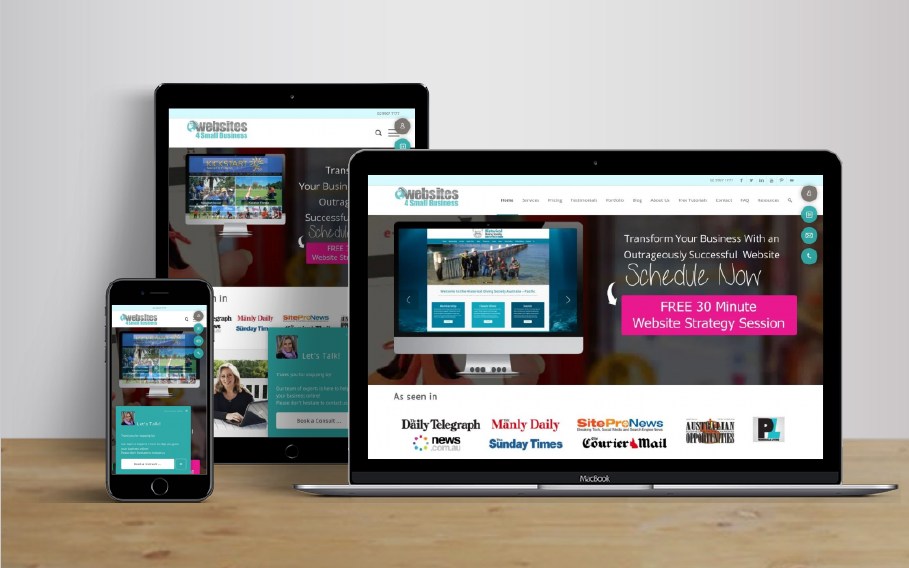
15. Optimise for Search Engines
If ranking highly in Search Engines to increase website traffic is part of your marketing strategy, I would recommend you hire an expert to optimise your website. Google algorithms change constantly and unless you have a solid SEO strategy and are working on optimising your website every day it’s difficult to keep up.
However to get SEO done properly involves a lot of work and can be quite costly.
If your budget doesn’t stretch that far and you would like to tackle SEO yourself, check out the following video by Matt Cutts from Google who explains how Google ranks pages.
Remember though, driving traffic to your website is only part of the process. You also need to make sure your website converts visitors into paying customers. Find out how to increase your visitor conversion rate.
Matt Cutts explains how search works
Pro Tip:
The speed of a website’s page loading time is a crucial factor when it comes to user experience. When pages take too long to load, visitors are likely to quickly navigate away from the site or give up entirely, which affects user engagement, search engine rankings and conversions.
Optimizing page loading times by reducing file sizes and leveraging caching can help ensure that visitors remain on your website longer and have a better overall experience.
Then check out:
16. Backup Website
Over the past year I have seen several small business owners go through so much stress because of problems with their website.
I cannot stress highly enough how important it is to keep your own website back ups.
There are many things that can go wrong with technology and although the webhosting company does regular backups, these are created in case something happens to the server and are generally NOT suitable for single website recovery.
As such, it is important that you keep your own backups in case your website suddenly stops working or gets hacked (unfortunately this happens more often than most small business owners are aware of).
If your website gets hacked, you may not be aware of it for several weeks or even several months as hackers can install code within your website without you seeing any difference to the functionality.
It is not until Google displays a warning message instead of your website which says “This site may harm your computer” or drops you from their listing that you may be made aware of it. And by then your backups may be infected as well. So it is vital you keep several copies of your backups.
Here are instructions on how to backup your website via your CPANEL,
If you have any questions about the Website Design Checklist or if the whole process seems overwhelming and you would like to talk to someone about creating a website for your business, then book for a free Website Strategy Session.
For more information, check out:



